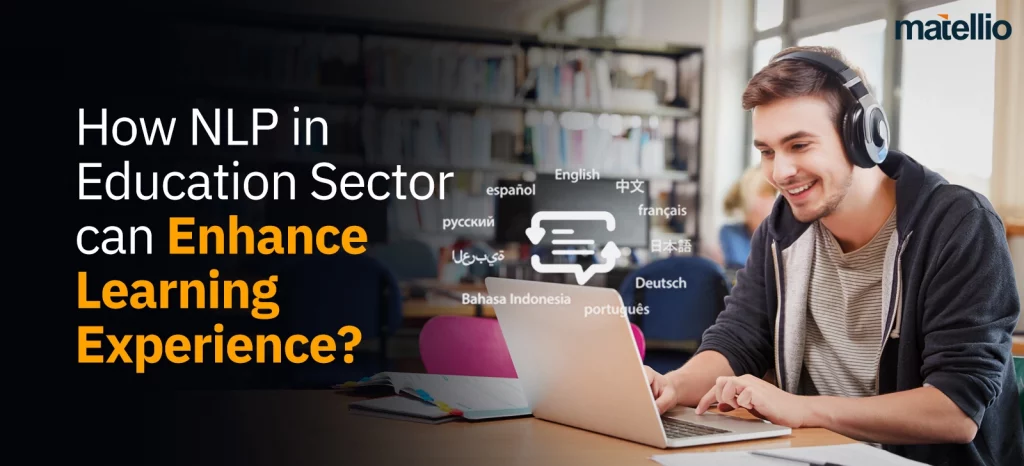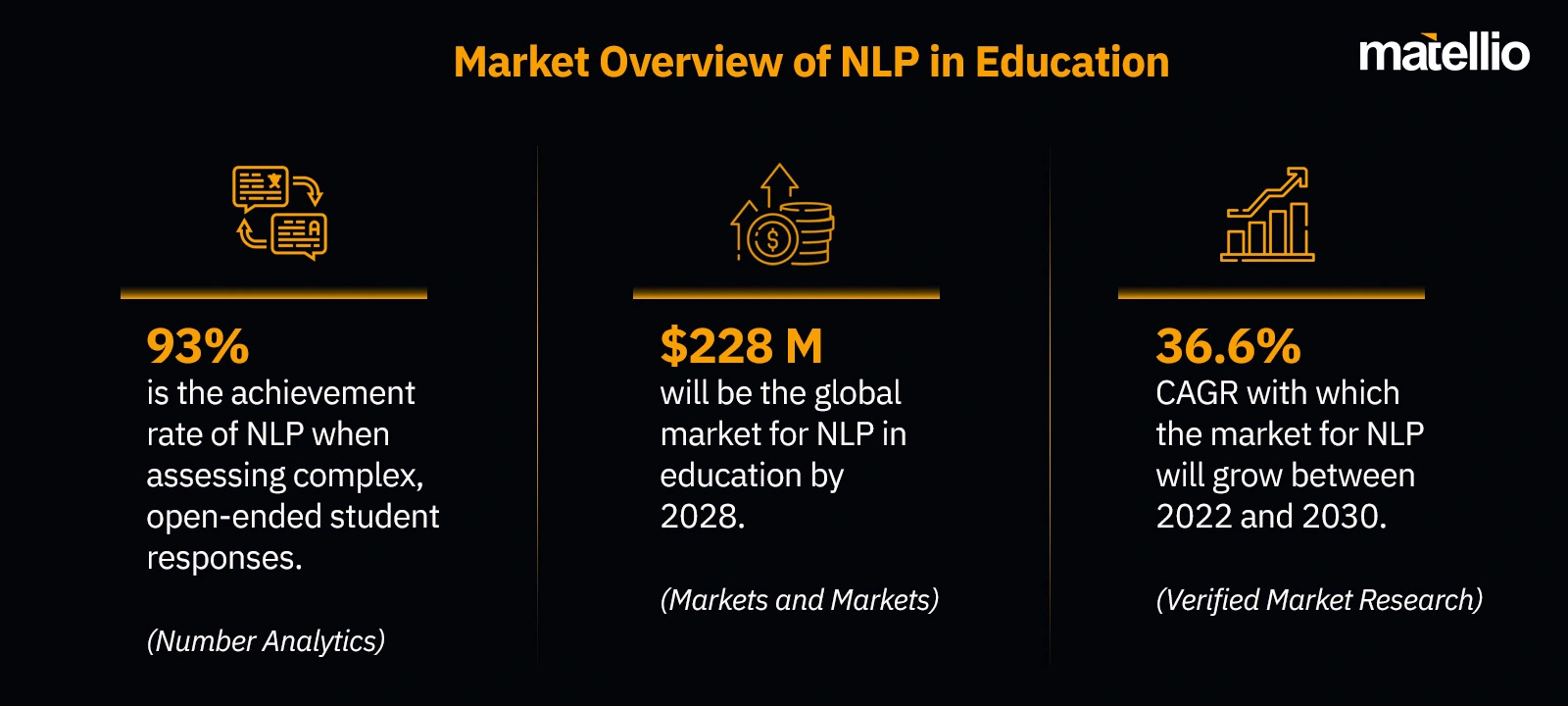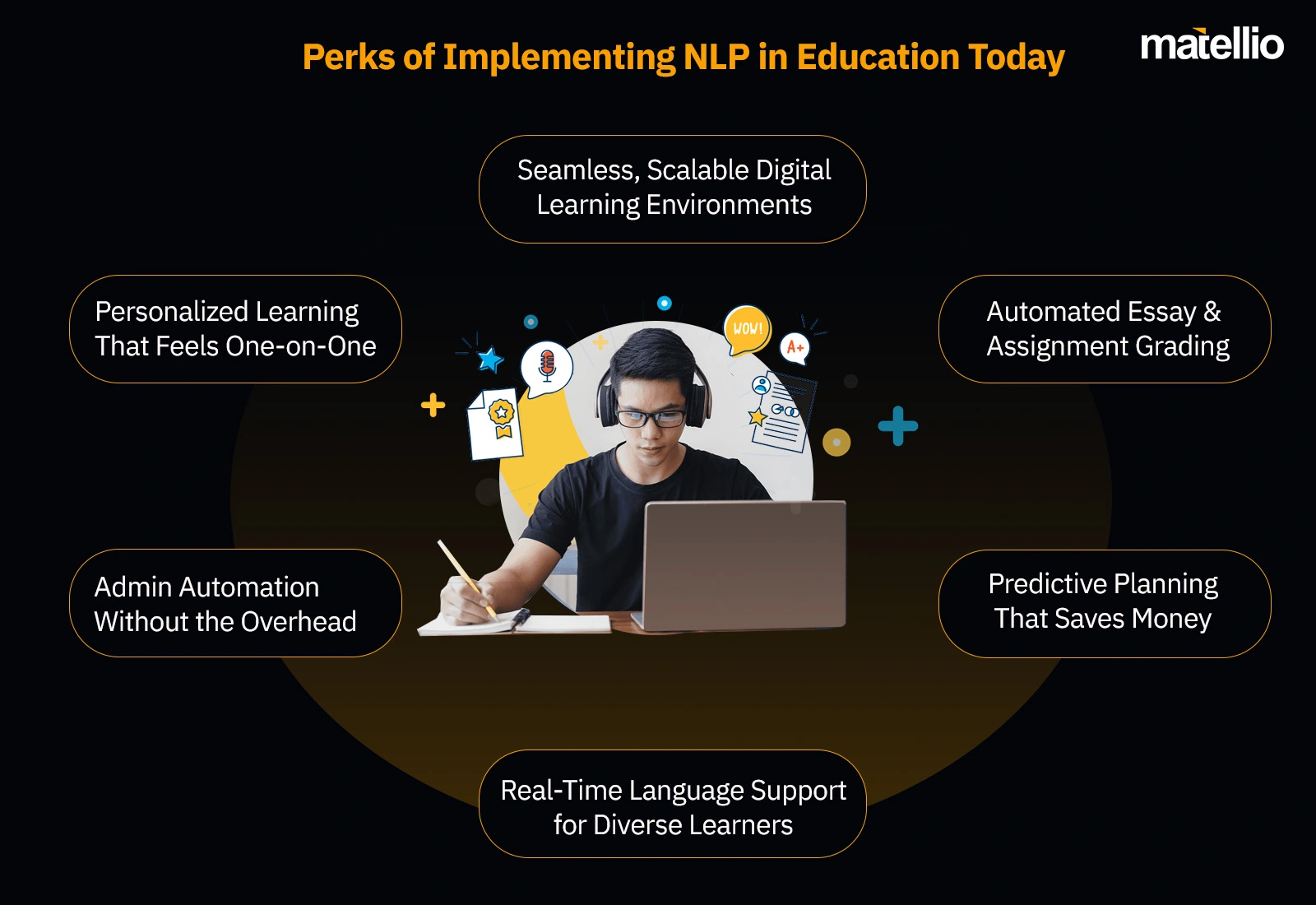
What would you do if you got some free time from your everyday chaotic administrative tasks? Or if your teachers suddenly had a few extra hours in the day—while AI handled the grading, responded to repetitive student queries, analyzed academic performance, and even translated international student questions into their native language? Yes, this is exactly what NLP in education offers.
And it’s no longer experimental—it’s essential. We’re talking smarter grading, AI-powered tutoring systems, real-time language comprehension, personalized feedback, and a whole new level of academic support—made possible by AI in natural language processing for education.
Still not convinced? Consider this: According to Grand View Research, the global market for natural language processing in education is projected to grow to $25.79 billion by 2030, with a CAGR of 33.7%, driven by the demand for intelligent learning environments.
Your competitors? They’re already using NLP applications in education to automate grading, personalize learning, track student performance, and give their teachers actual superpowers.
So, the question isn’t “Should we explore this?” It’s: “How long can we afford not to?”
Let’s break down what NLP for learning really looks like, how it works, and why institutions that are already using it are leading the next era of education.
Natural Language Processing in Education: A Quick Overview
Let’s keep it simple—Natural Language Processing (NLP) is the brain behind how machines understand, interpret, and even respond to human language. It uses powerful algorithms to break down speech and text, analyze sentence structure (a.k.a. parsing), detect intent, and deliver human-like responses.
So, when a student asks a chatbot, “Can you help me understand this math problem?”—NLP in education makes sure the system understands the question, the context, and how to respond intelligently.
It doesn’t stop there. NLP pulls strength from other AI-powered education technologies like deep learning and even computer vision in education, making it one of the most powerful tools in your digital toolkit.
And this isn’t just theory—the global NLP market is exploding. According to Fortune Business Insights, it was valued at USD 20.80 billion in 2021, and it’s projected to skyrocket to USD 161.81 billion by 2029, growing at a CAGR of 18.1%.
Here are some compelling, data-driven statistics that highlight the transformative impact of Natural Language Processing (NLP) in education:

So yes, the future of NLP is massive—and the institutions leveraging it now are seeing real results in efficiency, engagement, and experience.
Let’s now look at some powerful applications of NLP in education and how they’re changing the way learning happens.
Top Benefits of Using NLP in Education – What Can You Enjoy
Let’s not beat around the bush—NLP in education isn’t a future concept anymore. It’s here, and it’s already reshaping how top institutions teach, scale, and support students. Here’s how schools and EdTech platforms are winning with it—and what your institution is missing out on.

Personalized Learning That Feels One-on-One
With NLP for learning, your platform becomes smart enough to adapt to each student. By analyzing test scores, participation, and even written responses, NLP services help tailor educational content to fit every student’s pace, learning style, and areas of struggle.
What it gives you:
- Hyper-personalized content suggestions
- More engaged students, less dropout
- AI-powered tutoring systems that adapt in real time
Admin Automation Without the Overhead
Tired of staff spending hours answering the same 12 questions? With natural language processing in education, your system can handle common inquiries, send assignment reminders, or even summarize lectures using AI-powered education tools—all automatically.
What it gives you:
- NLP chatbots that never take a break
- Freed-up teacher time to focus on real teaching
- Better student satisfaction through faster response
Real-Time Language Support for Diverse Learners
One of the most direct applications of NLP in education is breaking language barriers. Whether it’s translating queries from international students or helping ESL learners with grammar and pronunciation, AI in natural language processing for education makes multilingual classrooms smarter and more inclusive.
What it gives you:
- Language-agnostic academic support
- Personalized, adaptive language learning
- Higher confidence and performance among diverse learners
Seamless, Scalable Digital Learning Environments
NLP applications in education let you deliver smarter online learning. From parsing student questions to automatically tagging and summarizing content, NLP makes your digital platform feel less like software and more like a learning partner.
What it gives you:
- Richer online learning experiences
- Reduced load on your LMS support teams
- Fast expansion of course catalogs without more headcount
Automated Essay & Assignment Grading
Application of NLP in education isn’t just for students—it’s a lifesaver for teachers. NLP tools can grade essays, detect grammar issues, and provide instant feedback, turning a full day of grading into a few minutes of review.
What it gives you:
- Objective grading based on real rubrics
- Consistent feedback across large student volumes
- Immediate insights into student performance trends
Predictive Planning That Saves Money
When you combine NLP with AI integration services, you unlock forecasting power. Systems can analyze past data to predict which digital resources will be in demand, when, and by whom—so you’re never underprepared or overspending.
What it gives you:
- Better resource allocation with less waste
- Smart scheduling for teachers and tools
- Actionable insights from your own usage data
Now this is how you actually apply NLP in education—not to replace your educators, but to empower them. And the schools doing this now? They’re already setting new benchmarks on student success, teacher satisfaction, and digital innovation.
Ready To Implement NLP in Education? Let’s Begin with A Free 30-minute Consultation!
Real-World Applications of NLP in Education: What You Can Actually Do with It
Let’s get practical. If you’re a decision-maker at an educational institution, this is where the magic happens. Here’s exactly how you can leverage NLP in education to modernize your operations, elevate student experiences, and free your team from time-draining tasks.
These aren’t buzzwords—these are scalable, high-ROI moves backed by real NLP applications in education.
Grammar Checker Solutions
Use natural language processing in education to power AI-based grammar checkers that go way beyond spell check. These tools help students write better, cleaner, and more readable content while supporting teachers in reviewing assignments.
NLP algorithms can analyze syntax, word choice, and tone, offering intelligent suggestions in real time—transforming average essays into A-grade submissions.
What it gives your institution:
- Smarter writing support with real-time suggestions
- Less manual correction for educators
- More confident, articulate students
Intelligent Tutoring Systems (ITS)
This is where AI-powered tutoring systems meet personalization. ITS platforms use AI in natural language processing for education to interpret student queries, analyze performance data, and deliver customized content—on the fly.
Each student gets a unique path, tailored to their learning style, speed, and academic gaps—without increasing your staff load.
What it gives your institution:
- Scalable 1:1 learning without 1:1 resources
- Consistent academic support, day or night
- Personalized content based on real-time insights
NLP-Based Chatbots for Student Support
Deploy NLP-based chatbots to automate everything from course FAQs to fee reminders and post-class queries. Available 24/7, they cut down on email overload and admin stress while providing instant responses to students.
These bots learn over time—handling thousands of queries with a personal touch.
What it gives your institution:
- Round-the-clock student support
- Fewer repetitive tasks for admin teams
- Higher student satisfaction and retention
Sentiment Analysis for Course & Faculty Feedback
Using NLP in education, you can analyze student reviews, forum discussions, and survey data to detect sentiment and emotional tone.
This lets you know what’s working—and what’s not—without waiting for end-of-semester reviews.
What it gives your institution:
- Real-time insight into student satisfaction
- Early alerts to disengagement or dissatisfaction
- Data-driven curriculum and faculty improvements
Smart Data Analysis & Content Creation
NLP can scan student submissions, LMS activity, and academic performance to spot patterns—and generate actionable insights. This enables you to create AI-powered education content that adapts to student needs.
You can even generate or restructure eLearning materials using NLP applications in education, automating content customization at scale.
What it gives your institution:
- Intelligent lesson planning
- Dynamic content curation
- Better-targeted eLearning delivery
Text Analysis for Curriculum Optimization
Leverage NLP services to scan textbooks, research papers, and instructional content. Identify recurring themes, frequently asked concepts, and usage patterns to refine course materials.
This makes your content library searchable, trackable, and measurable in ways you’ve never experienced before.
What it gives your institution:
- Enhanced academic resource planning
- Smarter curation of content libraries
- Improved student outcomes through better materials
Automated Feedback Systems
NLP lets you deliver personalized feedback at scale. Whether it’s on an essay, quiz, or discussion post, NLP in education tools can instantly analyze submissions and offer constructive, contextual suggestions.
Teachers save time. Students improve faster.
What it gives your institution:
- Instant, objective, and personalized feedback
- Reduced grading time by 40–60%
- Continuous improvement tracking across cohorts
These aren’t just hypothetical ideas. This is how forward-thinking schools and EdTech platforms are using NLP in education today—to scale, simplify, and seriously improve outcomes.
Still on the fence? Schedule a free 30-minute consultation with our experts to learn about the best use case of NLP in education for your business!
How to Implement NLP in Education (Without Burning Budget or Time)
So, you’ve seen the power of NLP in education—from personalized learning and real-time feedback to scalable student support and smart resource planning. But how do you actually bring it to life in your institution?
Here’s the roadmap we use when guiding educational leaders through real-world NLP applications in education—without the fluff or complexity.
Start With Clear Goals
First, identify where you want NLP in education to make the most impact. Is it automating grading? Powering AI-powered tutoring systems? Boosting online engagement through chatbots?
When you partner with an eLearning software development company, having clear goals helps design NLP features that align with your educational strategy and business model.
Build a Lean MVP First
Before diving deep into full-scale rollout, start with a minimum viable product (MVP). Whether it’s a chatbot for student FAQs or a simple sentiment analysis dashboard, an MVP gives you real-world feedback—fast.
That’s the smartest way to validate AI in natural language processing for education with minimal risk.
Choose the Right NLP Tech Stack
This is critical. You’ll need the right mix of NLP services, AI frameworks, APIs, and LMS integrations to make things run smoothly. Choose tools that are proven, scalable, and integrate seamlessly into your existing systems.
Pro tip: Look for tech partners with experience in both NLP for learning and AI integration services. The overlap is what makes the magic happen.
Partner With an NLP-Driven AI Development Company
NLP isn’t a plug-and-play solution—it requires strategic thinking, precise development, and ongoing iteration. That’s why you need a partner with proven success in AI eLearning software development and a strong portfolio of computer vision in education and NLP projects.
A true partner won’t just build features—they’ll guide your digital transformation, avoid costly detours, and ensure your solution delivers actual results.
And this is exactly where Matellio comes in.
Looking for a Trusted NLP Services Company? Your Search Ends Here! Contact Us for a Free Consultation Today.
Why Matellio Is Your NLP Partner in Education—Not Just Another Vendor
Let’s be blunt: anyone can claim they “do NLP.” But when you’re building AI-powered education platforms that affect real students, real teachers, and real outcomes—you need more than just code. You need expertise. You need precision. You need a partner who knows what success in the education industry actually looks like.
That’s Matellio.
We’ve spent years engineering tailored NLP applications in education, building everything from AI-powered tutoring systems and intelligent chatbots, to full-blown eLearning software development ecosystems that integrate seamlessly with LMS, CRMs, and live classrooms.
Deep NLP Expertise
We don’t just offer NLP services—we live and breathe them. From sentiment analysis and grammar engines to intelligent content curation and live chat automation, we’ve built it, scaled it, and optimized it in real-world classrooms and global EdTech platforms.
All-in-One AI Integration Services
NLP in education alone isn’t enough. We blend it with computer vision in education, predictive analytics, and ML model development services to deliver platforms that think holistically—because that’s how real learning happens.
Enterprise Reliability, Startup Agility
We move fast, adapt faster, and deliver with the rigor of an enterprise-grade team. Whether you’re running a growing EdTech company or transforming a legacy school system, we tailor our solutions to your exact model.
End-to-End Product Development
From planning and prototyping to launch and post-launch optimization, our AI eLearning software development approach means you get strategy, development, QA, and support—without the juggling act of hiring multiple vendors.
Proven Experience in EdTech
We’ve delivered scalable, secure, and student-centric solutions for some of the most innovative names in education. We know how to align NLP in education with business outcomes—because we’ve done it, again and again.
You Talk, We Listen—and Then Deliver
No tech talk. No off-the-shelf bloat. We translate your goals into intelligent solutions that work from day one
So, here’s the real question: If your competitors are already using NLP in education to scale smarter, engage better, and operate leaner—what’s stopping you? Let’s build your competitive edge today. Schedule a free 30-minute call


